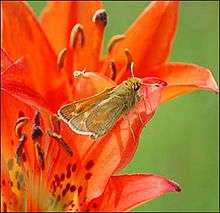Hesperia dacotae
| Dakota skipper | |
|---|---|
 | |
| Scientific classification | |
| Kingdom: | Animalia |
| Phylum: | Arthropoda |
| Class: | Insecta |
| Order: | Lepidoptera |
| Family: | Hesperiidae |
| Genus: | Hesperia |
| Species: | H. dacotae |
| Binomial name | |
| Hesperia dacotae (Linnaeus, 1758) | |
The Dakota skipper (Hesperia dacotae) is a small to medium-sized North American butterfly. It has a wingspan of approximately one inch and the antennae form a hook. The male’s wings are a tawny-orange to brown on the forewings with a prominent mark and dusty yellow on the lower part of the wing. The female wing is a darker brown orange and white spots on the forewing margin.
Reproduction
The adult Dakota skippers are active for only three weeks in June and July which is their total lifespan. Their eggs, which are laid on the underside of leaves, are hatched in July and the caterpillar larvae feed on native grass until they go dormant in late summer. The caterpillar larvae then winter in shelters very close to the ground. In spring they come out of dormancy in their adult form. They are found in healthy natural tall grass and prairie grass from Minnesota to Saskatchewan. They are now considered extinct in Illinois and Iowa. The largest most stable population is now found in North Dakota.
Candidate species
The U.S. Fish and Wildlife Service has placed the Dakota skipper butterfly on the Candidate list for the Endangered Species Act because of declining populations from development of native prairie for grazing, herbicide use and building. The Dakota skipper has had a priority of eleven on a scale one to twelve on the candidate list since 1975.
References
- World Conservation Monitoring Centre (1996). "Hesperia dacotae". IUCN Red List of Threatened Species. Version 2006. International Union for Conservation of Nature. Retrieved 11 May 2006. Listed as Vulnerable (VU A1c+2c v2.3)
External links
- Dakota skipper (Hesperia dacotae)
- U.S. Fish and Wildlife Service
- Endangered insects (pdf)
- FWS Field Office
- Species at risk
